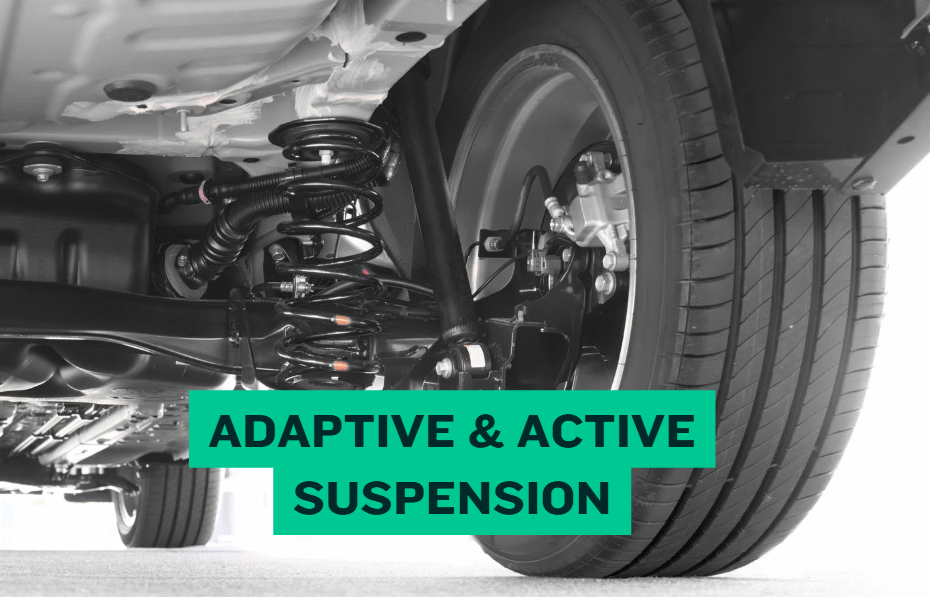I’ve driven cars with fancy suspension tech. I’ve felt what works and what doesn’t.
I want to share what I’ve learned about Adaptive & Active Suspension Systems Explained:
Pros, Cons & Real-World Use. I’ll keep it simple.
We’ll explore how these systems work, what they offer, where they fall short, real use, and whether they’re worth it for you.
What Are Adaptive and Active Suspension Systems
When I talk about adaptive suspension system or active suspension system, I mean systems that change how the car rides—while you’re driving. They adjust stiffness, damping, ride height, even per wheel. They aim to balance comfort and handling.
Adaptive suspension tweaks damping (how soft or hard the shocks are) based on road surface and driving style. It doesn’t add force; it changes how the shocks respond. Think electronic damping control, magnetic ride control, adaptive dampers.
Active suspension goes further. It uses actuators (hydraulic or electric) to push or pull parts of suspension. It can alter ride height, reduce body roll and pitch actively.
They both use sensors, a control computer, and adjustable parts. But active suspension has more moving parts and more control.
How They Work in Real Time
I like to imagine a smart mattress. If you lie still, it softens. If you toss and turn, it stiffens. That’s similar to how adaptive/active suspension works.
-
Sensors (on wheels, chassis, steering, speed) detect road bumps, curves, acceleration, braking.
-
The control unit (computer) processes this info instantly.
-
Adaptive dampers open or close valves, or magnetic fluids stiffen or soften. Active parts might push/pull to reduce body roll or adjust ride height.
So in tight turns or fast braking, the car doesn’t lean or pitch much. On rough road, you don’t feel every bump.
Pros: What I Loved When I Used Them
Ride Comfort vs Handling: They give both. In comfort mode, ride is smooth. In sport or performance mode, car feels tighter, more planted.
Better Safety: Less body roll, better contact with road. Braking feels more stable. Electronic stability and suspension control works better.

Smart Suspension Technology allows drive modes (comfort, sport, normal) so you choose what fits.
Real-Time Suspension Adjustment means the car adapts to potholes, curves, load changes.
Luxury Car Suspension Systems often include this. It adds prestige and feel. Magnetic ride control (as in GM cars) is one example I’ve felt.
Cons: Things That Disappoint or Cost You
Adaptive Suspension Cost is high. Buying a car with this system adds a premium.
Maintenance and Reliability: More parts, more sensors, more electronics means more things that can fail. Adaptive dampers, electronic control units, sensors—they’re not cheap.
Weight & Complexity: The extra components add weight. That can slightly hurt fuel economy. Also more wiring, diagnostics.
Feel Loss: Sometimes you lose “road feel.” The car filters out too much vibration. Some drivers feel disconnected.
Cost of Repair: If something breaks, it might need specialist tools or tech. Not every mechanic can fix this easily.
Adaptive vs Active: Difference Between Them
| Feature | Adaptive Suspension | Active Suspension |
|---|---|---|
| Adds force or just changes damping? | Just changes damping (how soft/stiff shocks are) | Adds force via actuators; can reposition parts of suspension |
| Ride height changes? | Usually no, or limited | Yes, more control over height |
| Complexity & energy use | Less energy, fewer moving heavy parts | More complex, more energy use |
| Cost & maintenance | Lower than active, but still expensive | Generally higher cost & maintenance required |
So if you want firmer handling but don’t care about adjusting height, adaptive may do. If you want full control (height, roll, pitch), active is better—but with higher cost.
Real-World Use: Cars, Situations, What It Feels Like
Luxury cars (Mercedes, BMW, Audi) often offer active body control, magnetic ride control. In city, in traffic, adaptive dampers smooth out bumps. On highway, the car feels planted.
Sports cars sometimes use active suspension to allow for firm handling in curves and smooth ride on straights. The balance is tricky.
SUV and trucks use adaptive and active to improve ride comfort while carrying loads, or towing. Ride height adjustment helps over rough ground or speed bumps.
Off-road: Active or adaptive helps, but the parts can get stressed. Dirt, water, rough terrain increase wear risk.
In everyday use, I noticed on rough city streets, adaptive dampers really help. But big potholes will still jolt you. Also, in colder weather, some sensors or systems react slower until everything warms up.
How Much Does It Cost & Is It Reliable
From what I’ve checked and what I felt:
Adding these systems adds thousands of dollars upfront. If you buy a car with active suspension, expect higher sticker price.
Reliability is decent in good brands, but expect more service. Sensor failures, damper failures, ECU or actuator issues can happen.
Warranty coverage helps. But after warranty, repair or replacement parts cost a lot.
Cost-benefit depends on how you drive: if lots of highway & smooth roads, maybe you’ll hardly use full ability. If twisty roads, hills, rough city roads, you’ll notice the benefit.
Which Cars Are Known for Best Adaptive/Active Suspension
GM’ magnetic ride control in certain Camaros, Cadillacs
Luxury SUVs and sedans from Mercedes with Active Body Control
Performance cars from brands like Audi, BMW, Porsche offering adaptive dampers or full active suspension
If you want best adaptive suspension cars, look for: good reviews of comfort & handling, strong reputation for reliability, good service network.
Pros and Cons Summed Up
Pros: better comfort, better handling, safety, flexibility (drive modes), smoother ride in mixed road conditions.
Cons: higher cost, weight, possible loss of road feel, more things that can break, expensive repairs.
Who Should Get Adaptive or Active Suspension
I ask myself: Do I drive on rough roads? Do I care about sporty handling? Do I want luxury feel? Am I okay with higher maintenance cost?
If yes: go for adaptive or active.
If mostly city, smooth roads, low budget, then maybe a well-tuned passive suspension is enough.
What to Check Before Buying a Car With This Tech
Can the system be serviced locally? Is there a good repair network?
What mode options are there (comfort, sport, adaptive, etc.)?
How does it feel on roads I usually drive? Rent or test drive.
Warranty & cost of parts.
Weight and energy impact (fuel efficiency, etc.).
Future of Suspension Systems
More smart suspension technology, better sensors, faster actuators. Systems will respond more quickly.
Integration with AI or predictive systems: a camera sees a bump, system prepares ahead.
More electric and hybrid vehicles will use lighter active/adaptive systems to keep efficiency high.
Cost will likely go down with scale.
To Sum Up
I’ve explored what adaptive and active suspension systems do. They add comfort, handling, and safety.
They also cost more and need more care. If I were you, I’d test drive one on roads like mine. See if it’s worth the price.
Thanks for reading this post.
